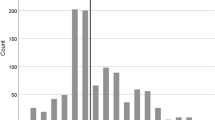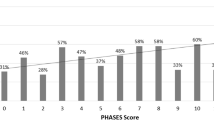Abstract
Background and objective
Aneurysm rebleeding after rupture can result in a catastrophic outcome with high mortality and morbidity. In this study, we evaluated the correlation of IARS (intracranial aneurysm rupture score) and aneurysm rebleeding. The aim of this study was to explore the clinical utility of IARS for better clinical decision-making.
Method
The patients with ruptured intracranial aneurysms between January 2017 and September 2018 were reviewed. Propensity scoring match was performed to construct a cohort. The morphological and hemodynamic parameters were obtained. The difference between stable aneurysms and rebleeding aneurysms was compared. Subsequently, the correlation of IARS and aneurysm rebleeding was studied.
Results
The matching process constructed a cohort, including 5 rebleeding aneurysms and 15 stable aneurysms. By comparing the difference between stable aneurysms and rebleeding aneurysms, the statistical significance was found in diameter of neck (p = 0.036), aspect ratio (p = 0.004) and size ratio (p = 0.029), normalized wall shear stress average (p = 0.026), low shear area ratio (p = 0.028), oscillatory shear index (OSI) (p = 0.031), and deviated angle (p = 0.025). The IARS here had a strong correlation with the aneurysm rebleeding, and the interval from the first bleeding to the rebleeding tended to shorten with the increase of IARS (R = 0.715, p = 0.027). IARS had a good predicting value for the aneurysm rebleeding (area under the curve = 0.756, p < 0.001).
Conclusion
Based on this preliminary study, intracranial aneurysm rupture score may correlate to the rebleeding in ruptured aneurysms. For ruptured aneurysms with high IARS scores, surgery should be given priority, and medical treatment is not recommended.



Similar content being viewed by others
References
Szklener S, Melges A, Korchut A, Zaluska W, Trojanowski T, Rejdak R, Rejdak K (2015) Predictive model for patients with poor-grade subarachnoid haemorrhage in 30-day observation: a 9-year cohort study. BMJ Open 5:e007795
Cordonnier C, Demchuk A, Ziai W, Anderson CS (2018) Intracerebral haemorrhage: current approaches to acute management. Lancet. 392:1257–1268
Nieuwkamp DJ, Setz LE, Algra A, Linn FH, de Rooij NK, Rinkel GJ (2009) Changes in case fatality of aneurysmal subarachnoid haemorrhage over time, according to age, sex, and region: a meta-analysis. Lancet Neurol 8:635–642
Kienzler J, Marbacher S, Remonda L, Soleman J, Ai Schlaeppi J, Leupold U, Fandino J (2016) Outcome after in-hospital rebleeding of rupture of intracranial aneurysms. J Neurol Surg A Cent Eur Neurosurg 77:207–221
Jaechan P, Hyunjin W, Dong-Hun K, Yong-Sun K, Young KM, Im Hee S et al (2015) Formal protocol for emergency treatment of ruptured intracranial aneurysms to reduce in-hospital rebleeding and improve clinical outcomes. J Neurosurg 122:383
Rosenørn J, , Eskesen V, Schmidt K, Rønde F. The risk of rebleeding from ruptured intracranial aneurysms. J Neurosurg 1987;67:329–332
Fisher CM, Kistler JP, Davis JM (1980) Relation of cerebral vasospasm to subarachnoid hemorrhage visualized by computerized tomographic scanning. Neurosurgery. 6:1–9
Frontera JA, Claassen J, Schmidt JM, Wartenberg KE, Temes R, Jr CE, et al. Prediction of symptomatic vasospasm after subarachnoid hemorrhage: the modified fisher scale. Neurosurgery. 2006;59:21–27
Ko SB, Choi HA, Carpenter AM, Helbok R, Schmidt JM, Badjatia N, Claassen J, Connolly ES, Mayer SA, Lee K (2011) Quantitative analysis of hemorrhage volume for predicting delayed cerebral ischemia after subarachnoid hemorrhage. Stroke 42:669–674
Hijdra A, van Gijn J, Nagelkerke NJ, Vermeulen M, van Crevel H (1988) Prediction of delayed cerebral ischemia, rebleeding, and outcome after aneurysmal subarachnoid hemorrhage. Stroke 19:1250–1256
Frosen J, Tulamo R, Paetau A, Laaksamo E, Korja M, Laakso A et al (2012) Saccular intracranial aneurysm: pathology and mechanisms. Acta Neuropathol 123:773–786
Dolan JM, Kolega J, Meng H (2013) High wall shear stress and spatial gradients in vascular pathology: a review. Ann Biomed Eng 41:1411–1427
Meng H, Xiang J, Liaw N. The role of hemodynamics in intracranial aneurysm initiation. 2012;7:40–57
Meng H, Tutino VM, Xiang J, Siddiqui A (2014) High wss or low wss? Complex interactions of hemodynamics with intracranial aneurysm initiation, growth, and rupture: toward a unifying hypothesis. AJNR Am J Neuroradiol 35:1254–1262
Gian Marco DM, Hector L, J Michael S, Lord AS, Velander AJ, Andres F, et al. Impact of premorbid hypertension on haemorrhage severity and aneurysm rebleeding risk after subarachnoid haemorrhage. J Neurol Neurosurg Psychiatry 2014;85:56–59
Lin QS, Ping-Chen LYX, Lin ZY, Yu LH, Dai LS et al (2016) Systolic blood pressure variability is a novel risk factor for rebleeding in acute subarachnoid hemorrhage: a case-control study. Medicine 95:e3028
Jiang P, Liu Q, Wu J, Chen X, Li M, Li Z, Yang S, Guo R, Gao B, Cao Y, Wang S (2018) A novel scoring system for rupture risk stratification of intracranial aneurysms: a hemodynamic and morphological study. Front Neurosci 12
American Society of Anesthesiologists Task Force on Perioperative Blood M (2015) Practice guidelines for perioperative blood management: an updated report by the American Society Of Anesthesiologists task force on perioperative blood management. Anesthesiology. 122:241–275
Connolly ES Jr, Rabinstein AA, Carhuapoma JR, Derdeyn CP, Dion J, Higashida RT et al (2012) Guidelines for the management of aneurysmal subarachnoid hemorrhage: a guideline for healthcare professionals from the American Heart Association/American Stroke Association. Stroke. 43:1711–1737
Dhar S, Tremmel M, Mocco J, Kim M, Yamamoto J, Siddiqui AH, Hopkins LN, Meng H (2008) Morphology parameters for intracranial aneurysm rupture risk assessment. Neurosurgery. 63:185–197
Tian Z, Zhang Y, Jing L, Liu J, Zhang Y, Yang X (2016) Rupture risk assessment for mirror aneurysms with different outcomes in the same patient. Front Neurol 7:219
Xiang J, Natarajan SK, Tremmel M, Ma D, Mocco J, Hopkins LN, Siddiqui AH, Levy EI, Meng H (2011) Hemodynamic-morphologic discriminants for intracranial aneurysm rupture. Stroke 42:144–152
Lovelock CE, Molyneux AJ, Rothwell PM (2007) Oxford vascular S. change in incidence and aetiology of intracerebral haemorrhage in oxfordshire, Uk, between 1981 and 2006: a population-based study. Lancet Neurol 6:487–493
Jiang P, Wu J, Chen X, Ning B, Liu Q, Li Z, Li M, Yang F, Cao Y, Wang R, Wang S (2018) Quantitative proteomics analysis of differentially expressed proteins in ruptured and unruptured cerebral aneurysms by itraq. J Proteome 182:45–52
Torner JC, Kassell NF, Wallace RB, Adams HP (1981) Preoperative prognostic factors for rebleeding and survival in aneurysm patients receiving antifibrinolytic therapy: report of the cooperative aneurysm study. Neurosurgery. 9:506–513
Dhar S, Tremmel M, Mocco J, Kim M, Yamamoto J, Siddiqui AH, Hopkins LN, Meng H (2008) Morphology parameters for intracranial aneurysm rupture risk assessment. Neurosurgery. 63:185–196 discussion 196–187
Ghosh S, Dey S, Tjoumakaris S, Gonzalez F, Rosenwasser R, Pascal J, Jallo J (2013) Association of morphologic and demographic features of intracranial aneurysms with their rupture: a retrospective analysis. Acta Neurochir Suppl 115:275–278
Tremmel M, Dhar S, Levy EI, Mocco J, Meng H (2009) Influence of intracranial aneurysm-to-parent vessel size ratio on hemodynamics and implication for rupture: results from a virtual experimental study. Neurosurgery 64:622–630 discussion 630–621
Rahman M, Smietana J, Hauck E, Hoh B, Hopkins N, Siddiqui A, Levy EI, Meng H, Mocco J (2010) Size ratio correlates with intracranial aneurysm rupture status: a prospective study. Stroke. 41:916–920
Boogaarts HD, Lieshout JH, Van, Amerongen MJ, Van, Joost DV, Verbeek ALM, J André G, et al. Aneurysm diameter as a risk factor for pretreatment rebleeding: a meta-analysis. J Neurosurg 2015;122:921, 928
Skodvin TO, Evju O, Helland CA, Isaksen JG. Rupture prediction of intracranial aneurysms: a nationwide matched case-control study of hemodynamics at the time of diagnosis. J Neurosurg 2017:1–7
Goubergrits L, Schaller J, Kertzscher U, Petz C, Hege HC, Spuler A (2013) Reproducibility of image-based analysis of cerebral aneurysm geometry and hemodynamics: an in-vitro study of magnetic resonance imaging, computed tomography, and three-dimensional rotational angiography. J Neurol Surg A Cent Eur Neurosurg 74:294–302
Etminan N, Buchholz BA, Dreier R, Bruckner P, Torner JC, Steiger HJ, Hänggi D, Macdonald RL (2014) Cerebral aneurysms: formation, progression, and developmental chronology. Transl Stroke Res 5:167–173
Chalouhi N, Jabbour P, Hasan D (2014) Inflammation, macrophages, and targeted imaging in intracranial aneurysms. World Neurosurg 81:206–208
Hosaka K, Hoh BL (2014) Inflammation and cerebral aneurysms. Transl Stroke Res 5:190–198
Penn DL, Witte SR, Komotar RJ, Sander Connolly E Jr (2014) The role of vascular remodeling and inflammation in the pathogenesis of intracranial aneurysms. J Clin Neurosci 21:28–32
Starke RM, Chalouhi N, Ali MS, Jabbour PM, Tjoumakaris SI, Gonzalez LF, Rosenwasser R, Koch W, Dumont A (2013) The role of oxidative stress in cerebral aneurysm formation and rupture. Curr Neurovasc Res 10:247–255
Starke RM, Chalouhi N, Ding D, Raper DM, McKisic MS, Owens GK et al (2014) Vascular smooth muscle cells in cerebral aneurysm pathogenesis. Transl Stroke Res 5:338–346
Yan L, Zhu YQ, Li MH, Tan HQ, Cheng YS (2013) Geometric, hemodynamic, and pathological study of a distal internal carotid artery aneurysm model in dogs. Stroke. 44:2926–2929
Jou LD, Lee DH, Morsi H, Mawad ME (2008) Wall shear stress on ruptured and unruptured intracranial aneurysms at the internal carotid artery. AJNR Am J Neuroradiol 29:1761–1767
Malek AM, Alper SL, Izumo S (1999) Hemodynamic shear stress and its role in atherosclerosis. JAMA. 282:2035–2042
Bian LH, Liu YF, Nichols LT, Wang CX, Wang YL, Liu GF, Wang WJ, Zhao XQ (2012) Epidemiology of subarachnoid hemorrhage, patterns of management, and outcomes in China: a hospital-based multicenter prospective study. CNS Neurosci Ther 18:895–902
Xiang J, Siddiqui AH, Meng H (2014) The effect of inlet waveforms on computational hemodynamics of patient-specific intracranial aneurysms. J Biomech 47:3882–3890
Skodvin TO, Johnsen LH, Gjertsen O, Isaksen JG, Sorteberg A (2017) Cerebral aneurysm morphology before and after rupture: Nationwide case series of 29 aneurysms. Stroke. 48:880–886
Funding
This study was supported by the National Natural Foundation of China (Grant No. 81471210 and 81671129, Recipient: Shuo Wang) and Major special projects in the 13th five-year plan (Grant No.2016YFC1301800, Recipient: Shuo Wang).
Author information
Authors and Affiliations
Contributions
Author contributions to the study and manuscript preparation include the following. Conception and design: all authors. Acquisition of data: Q.L. Analysis and interpretation of data: Q.L, P.J. Drafting the article: Q.L. Critically revising the article: all authors. Reviewing submitted version of manuscript: all authors. Approving the final version of the manuscript on behalf of all authors: S.W. Administrative/technical/material support: S.W and B.G. Study supervision: S.W and J.W.
Corresponding author
Ethics declarations
Conflict of interest
All authors certify that we have no affiliations with or involvement in any organization or entity with any financial interest (such as honoraria; educational grants; participation in speakers’ bureaus; membership, employment, consultancies, stock ownership, or other equity interest; and expert testimony or patent-licensing arrangements), or non-financial interest (such as personal or professional relationships, affiliations, knowledge or beliefs) in the subject matter or materials discussed in this manuscript.
Additional information
Publisher’s note
Springer Nature remains neutral with regard to jurisdictional claims in published maps and institutional affiliations.
Rights and permissions
About this article
Cite this article
Liu, Q., Jiang, P., Wu, J. et al. Intracranial aneurysm rupture score may correlate to the risk of rebleeding before treatment of ruptured intracranial aneurysms. Neurol Sci 40, 1683–1693 (2019). https://doi.org/10.1007/s10072-019-03916-1
Received:
Accepted:
Published:
Issue Date:
DOI: https://doi.org/10.1007/s10072-019-03916-1




